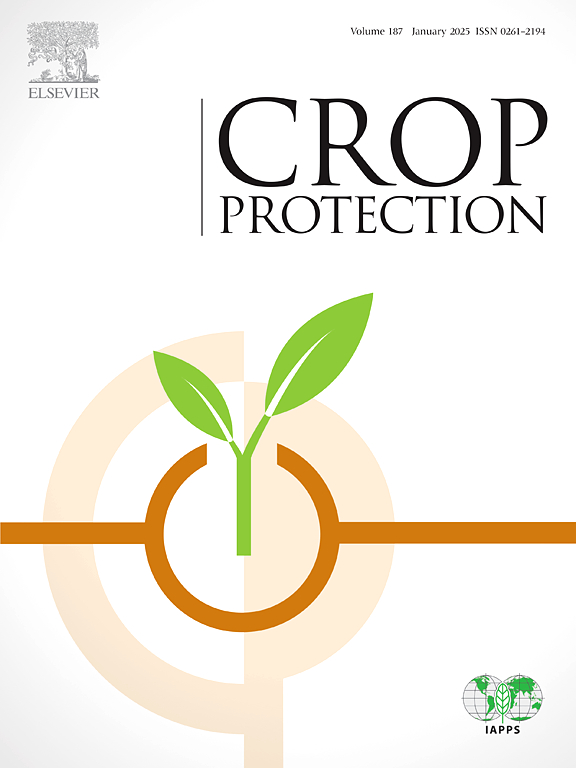通过血管输送土霉素管理柑桔生产中的黄龙病
IF 2.5
2区 农林科学
Q1 AGRONOMY
引用次数: 0
摘要
细菌性病害黄龙病(HLB)严重危害着世界各地的柑橘产业。近年来的研究表明,注射土霉素(OTC)是降低病原菌滴度和恢复柑橘树健康和生产力的有效方法。在这里,我们评估了OTC注射剂在佛罗里达州的一个商业柑橘园两个生产周期内减轻HLB的功效。在2022年5月和2023年5月,用两种不同的注射方法注射两种比例的OTC,并与未注射的树木进行比较。无论采用何种方法,OTC注射剂均显著提高了果产量和果汁品质。在较低的速率下(0.55克OTC/棵),果实产量在第1年和第2年分别增加66%和95%。在较高的速率下(1.1克OTC/树),果实产量在第一年增加了70%,在第二年增加了121%。水果的大小、重量、果汁的颜色和可溶性固形物都有显著的增加,这与OTC率无关,尽管较高的OTC率通常产生更好的结果。收获时收集的水果中的OTC残留物低于最大允许水平,无论比率如何。每次注射一年后测量的叶子细菌滴度在注射和未注射的树木之间没有差异,这表明发生了再感染,并且需要重复注射以维持这种治疗的有益效果。经济分析表明,OTC治疗在两个季节的累积结果是积极的,表明其收益大于成本。本文章由计算机程序翻译,如有差异,请以英文原文为准。
Managing endemic huanglongbing in commercial citrus production through vascular delivery of oxytetracycline
The bacterial disease huanglongbing (HLB) is devastating citrus industries around the world. Recent studies have identified trunk injection of oxytetracycline (OTC) as an effective method to reduce pathogen titers and restore citrus tree health and productivity. Here we assess the efficacy of OTC injections to mitigate HLB in a commercial citrus orchard in Florida over two production cycles. Nine-year-old ‘Valencia’ orange (Citrus sinensis) trees were injected with two rates of OTC in May 2022 and 2023 using two different injection methods and compared against non-injected trees. Regardless of the method, OTC injection significantly improved fruit yield and juice quality. At the lower rate (0.55 g OTC/tree) fruit yield increased by up to 66 % in year 1 and 95 % in year 2. At the higher rate (1.1 g OTC/tree) fruit yield increased by up to 70 % in year 1 and 121 % in year 2. Significant increases were also measured for fruit size, fruit weight, juice color, and soluble solids, regardless of the OTC rate although the higher rate generally produced better results. OTC residues in the fruits collected at harvest were below the maximum allowed level, regardless of the rate. Leaf bacterial titers measured one year after each injection were not different between injected and non-injected trees, suggesting that reinfection occurred and that repeated injections are necessary to maintain the beneficial effects of this therapy. The economic analysis showed that the cumulative result of OTC treatments over two seasons is positive, denoting that their benefit outweighed their cost.
求助全文
通过发布文献求助,成功后即可免费获取论文全文。
去求助
来源期刊

Crop Protection
农林科学-农艺学
CiteScore
6.10
自引率
3.60%
发文量
200
审稿时长
29 days
期刊介绍:
The Editors of Crop Protection especially welcome papers describing an interdisciplinary approach showing how different control strategies can be integrated into practical pest management programs, covering high and low input agricultural systems worldwide. Crop Protection particularly emphasizes the practical aspects of control in the field and for protected crops, and includes work which may lead in the near future to more effective control. The journal does not duplicate the many existing excellent biological science journals, which deal mainly with the more fundamental aspects of plant pathology, applied zoology and weed science. Crop Protection covers all practical aspects of pest, disease and weed control, including the following topics:
-Abiotic damage-
Agronomic control methods-
Assessment of pest and disease damage-
Molecular methods for the detection and assessment of pests and diseases-
Biological control-
Biorational pesticides-
Control of animal pests of world crops-
Control of diseases of crop plants caused by microorganisms-
Control of weeds and integrated management-
Economic considerations-
Effects of plant growth regulators-
Environmental benefits of reduced pesticide use-
Environmental effects of pesticides-
Epidemiology of pests and diseases in relation to control-
GM Crops, and genetic engineering applications-
Importance and control of postharvest crop losses-
Integrated control-
Interrelationships and compatibility among different control strategies-
Invasive species as they relate to implications for crop protection-
Pesticide application methods-
Pest management-
Phytobiomes for pest and disease control-
Resistance management-
Sampling and monitoring schemes for diseases, nematodes, pests and weeds.
 求助内容:
求助内容: 应助结果提醒方式:
应助结果提醒方式:


